
Emily Brontë
WUTHERING HEIGHTS: DOUBLE-TALK & DOUBLE VISION – PART 3
Stevie Davies
Posted by kind permission of Stevie Davies, novelist, essayist and short story writer; fellow of the Royal Society of Literature and the Welsh Academy; Professor of Creative Writing at Swansea University.
From Stevie Davies, Emily Brontë: Heretic (London: The Women’s Press, 1994) 88-101
THIS IS PART 3 OF THE ESSAY. READ PART 1 FIRST.
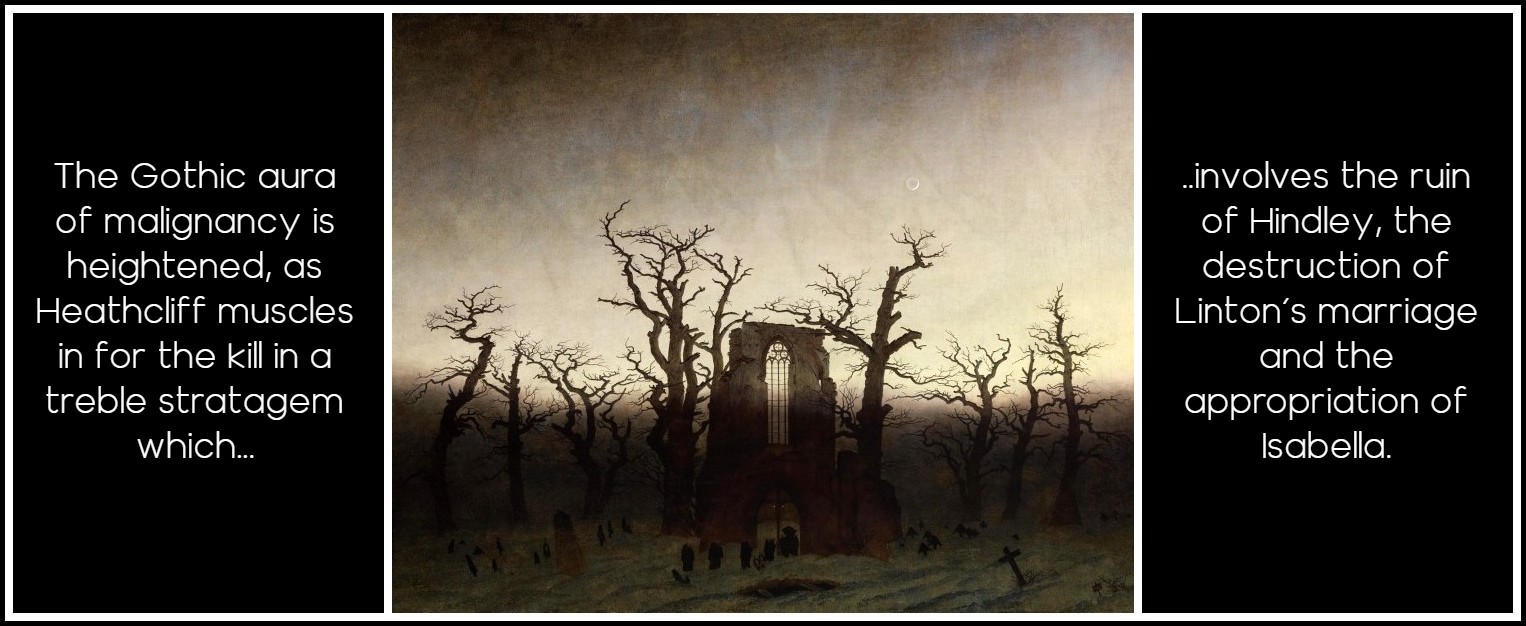
Caspar David Friedrich, Abbey among Oak Trees, 1810
Storm succeeds; lashing rain; a split bough; Joseph raving in prayer; the discovery of the vanishment of Heathcliff; Cathy’s suicidal delirium. Chapter IX closes with the ‘awakening’ of narrator and listener to self-consciousness; Nelly’s departure for bed and Lockwood’s groggy determination to sleep too. But in the minor key, the deathwards drift is hauntingly echoed in the rumour of a final quietus. Nelly has not ‘gone to bed’: she ‘is vanished to her rest’, and Lockwood will shortly follow. The author teases our eagerness for the story to go on being told by keeping Lockwood ill in bed for a month: when he revives, all Nelly seems disposed to talk about is his medicine. Lockwood testily demands to know where Heathcliff went after he fled. All Nelly will say is that she ‘couldn’t give my word for any’. Heathcliff came originally from the unknown, via Liverpool, and when he runs away it is to a textual nowhere. The young Emily’s hero, Sir Walter Scott, managed things differently: he observes the novel’s protocol to satisfy the reader with relevant information, so that there will be no holes or suppressions left: a contract which Emily Brontë betrays, on the principle that to sate the reader is to close the book. Apparently Heathcliff has given his enemy Hindley some account of his travels and rehabilitation, enough to prompt an invitation to ‘walk in’ but we are—almost contemptuously—excluded from the information. This narrative avarice gives the reject a second birth into the book, a revenant recovering from a form of linguistic death: the Gothic aura of malignancy is heightened, as he muscles in for the kill in a treble stratagem which involves the ruin of Hindley, the destruction of Linton’s marriage and the appropriation of Isabella.
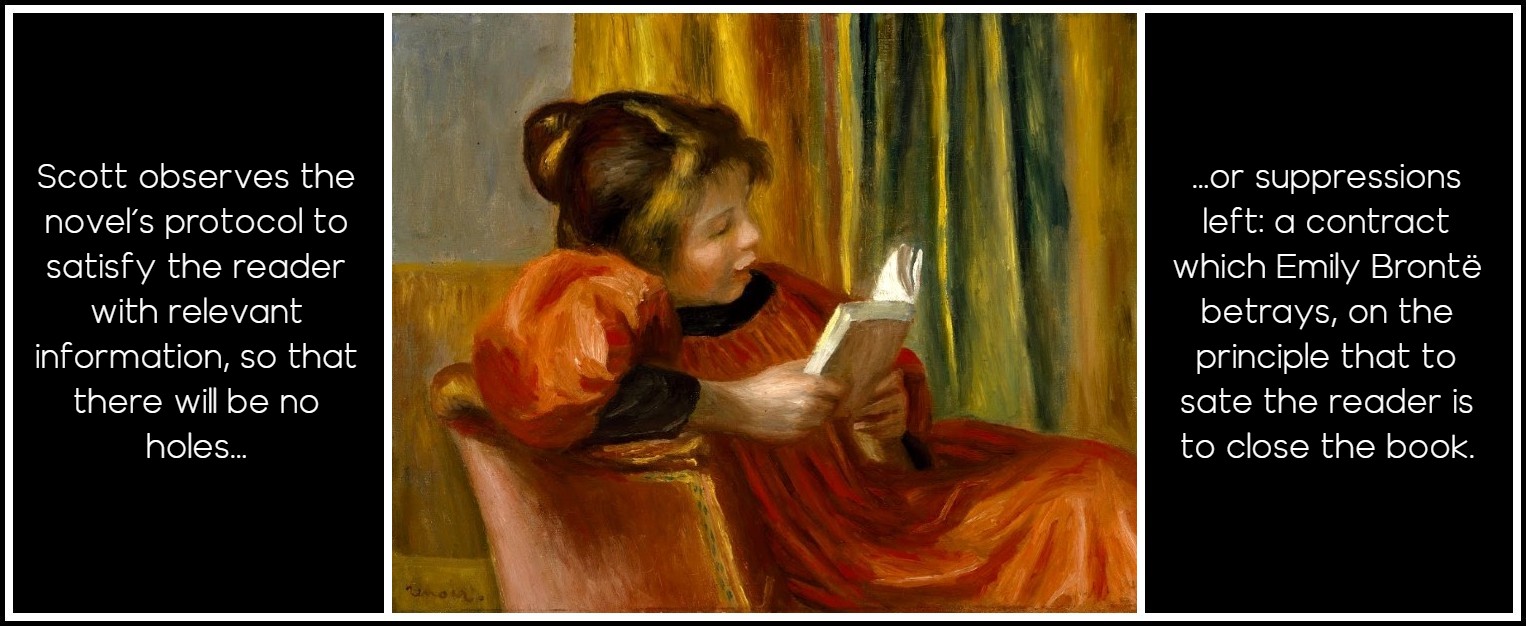
Renoir, Girl Reading, 1890
From the time of Heathcliff’s return, violence mounts, to climax in the quarrel in Chapter XI which precipitates Cathy’s breakdown and death. That violence becomes unremitting, an infernal way of life which expresses the hell within Heathcliff in a campaign of retributive sadism which only concludes with the disabling of his will through the mesmerism exerted by the real or imagined spectre of Catherine eighteen years after her death. A maelstrom of conflict is indeed the medium in which the divided characters of Wuthering Heights have to live. All the early reviewers reacted to or against it. The critic in Graham’s Magazine excelled himself thus: ‘How a human being could have attempted such a book as the present without committing suicide before he had finished a dozen chapters is a mystery. It is a compound of vulgar depravity and unnatural horrors, such as we might suppose a person, inspired by a mixture of brandy and gunpowder, might write for the edification of fifth-rate blackguards.’ The Examiner found itself unable to believe that such a brutal fiend as Heathcliff could be conceived as living ‘so near our own dwellings as the summit of a Yorkshire moor’, and to the Eclectic Review he was a ‘monster’. For us, re-reading a century and a half later, Heathcliff cannot be so denied: he has entered the lexicon of what we think of as human and are prepared to recognize in ourselves. In the sense that we know that abuse breeds abuse and hurt generates hate, the chain of violence within which he acts represents the inheritance of our misbegotten selves. The text, like the critics quoted above, attempts to dissociate itself from him, through denying him parents, name, origin, even humanity. ‘Is he a ghoul, or a vampire?’ Nelly is still asking towards the end of the book. He can only be tolerated if he is understood as the Not-I, Not-Us.
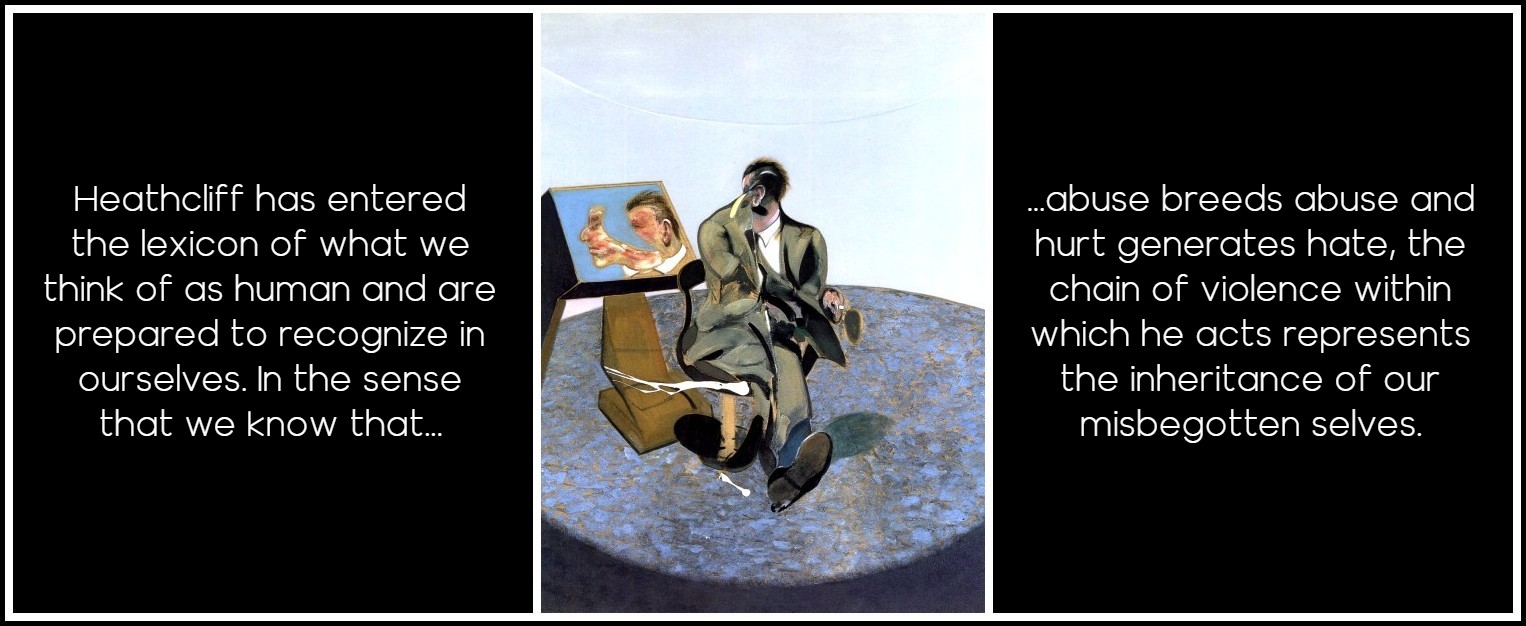
Francis Bacon, Self-Portrait, 1956
But Heathcliff is not a monster. He is a kind of norm. This perhaps is the most shocking thing of all: that the continuum of violence in Wuthering Heights represents the merest realism, actually in many lives, and potentially in all others. To be able to say ‘I am Heathcliff’ is to have grasped the terrible nettle of a book which does not address itself to readers fawned upon as ‘dear reader’ or ‘courteous reader’, ‘gentle reader’, stroked until we purr with the pleasure of confederate illusion. Wuthering Heights assaults rather than craves indulgence of its reader. Its action is an unremitting concatenation of quarrels, raining insults, blows, knives, gunshots, flinging objects and persons about or dropping them sensationally over the bannisters. The sardonic mode of address used by characters and narrator implies a violence which the plot interminably reproduces on the page in reiterated acts of manic cruelty. Heathcliff ‘kicked and trampled on’ Hindley, and ‘dashed his head repeatedly against the flags’; he snatches a dinner-knife and flings it at Isabella’s head; he treats the second Cathy to ‘a shower of terrific slaps on both sides of the head’. On and on goes the sordid mayhem until it becomes a dreary matter of fact. The world is like this, it seems to suggest, the stronger thrashing the weaker to pass on his damage.
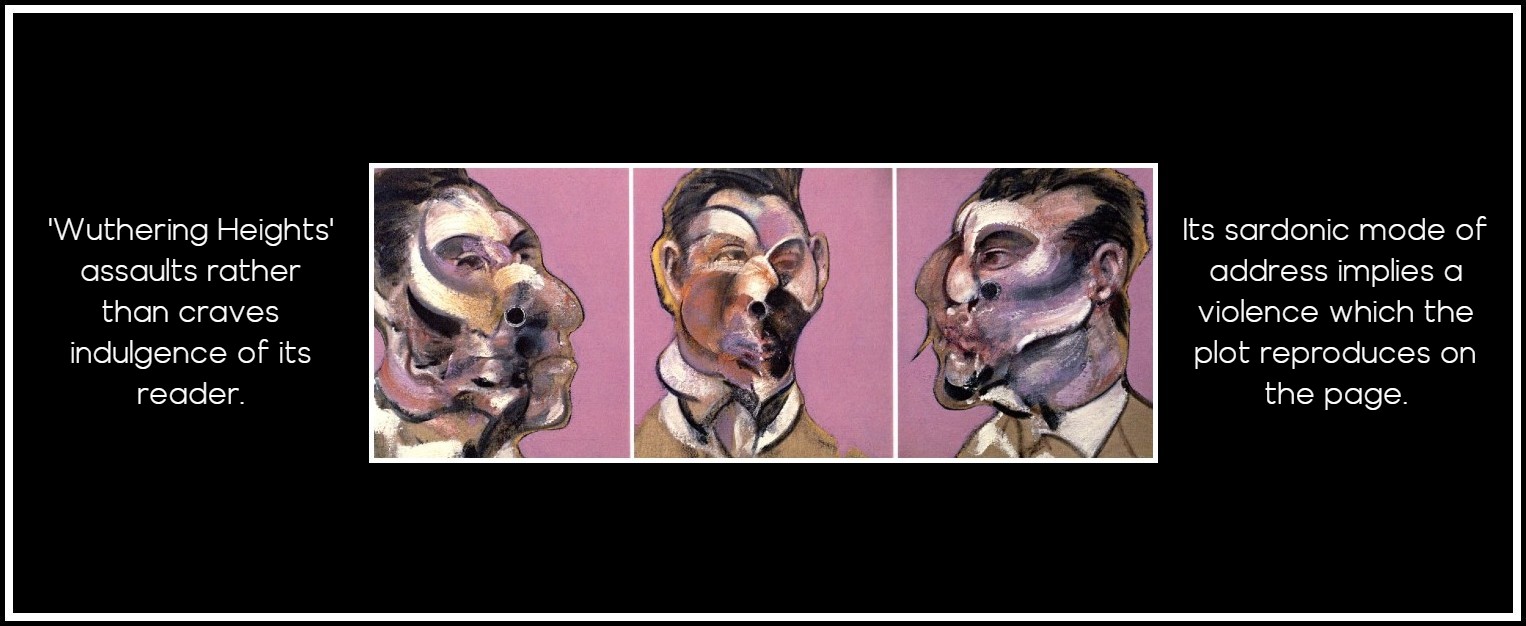
Francis Bacon, Three Studies of George Dyer, 1969
For the novel not only discharges violent energy on to the page but takes account of it. While the acts are stunningly incontinent, the narrating words give an impression of factual sobriety, measuring what they convey in the interests of giving an accurate and hence distanced picture. For instance Heathcliff’s attack on the younger Cathy is described in terms of the manoeuvring over the house-key. The infantile quality of domestic violence suggests its childhood origins but is universalized to include all creatures caught in a competitive system, which makes struggle for survival and possession the norm. When peace and love come for the second generation they are signalled by the second Cathy’s tuition of Hareton in the pronunciation of the word ‘contrary’. ‘Con-trary!’ she corrects him, threatening: ‘Recollect, or I pull your hair!’. In this novel of contraries, contradiction and contrariness, resolution takes the form of an agreed expression of a word for opposites. Mingling ‘her light shining ringlets with his brown locks’, the text presents an image which superficially reconciles contraries, but this is to some degree a cheat, for Cathy and Hareton are not true opposites but rather mirrorings of an original source. The conflict goes on, elsewhere.
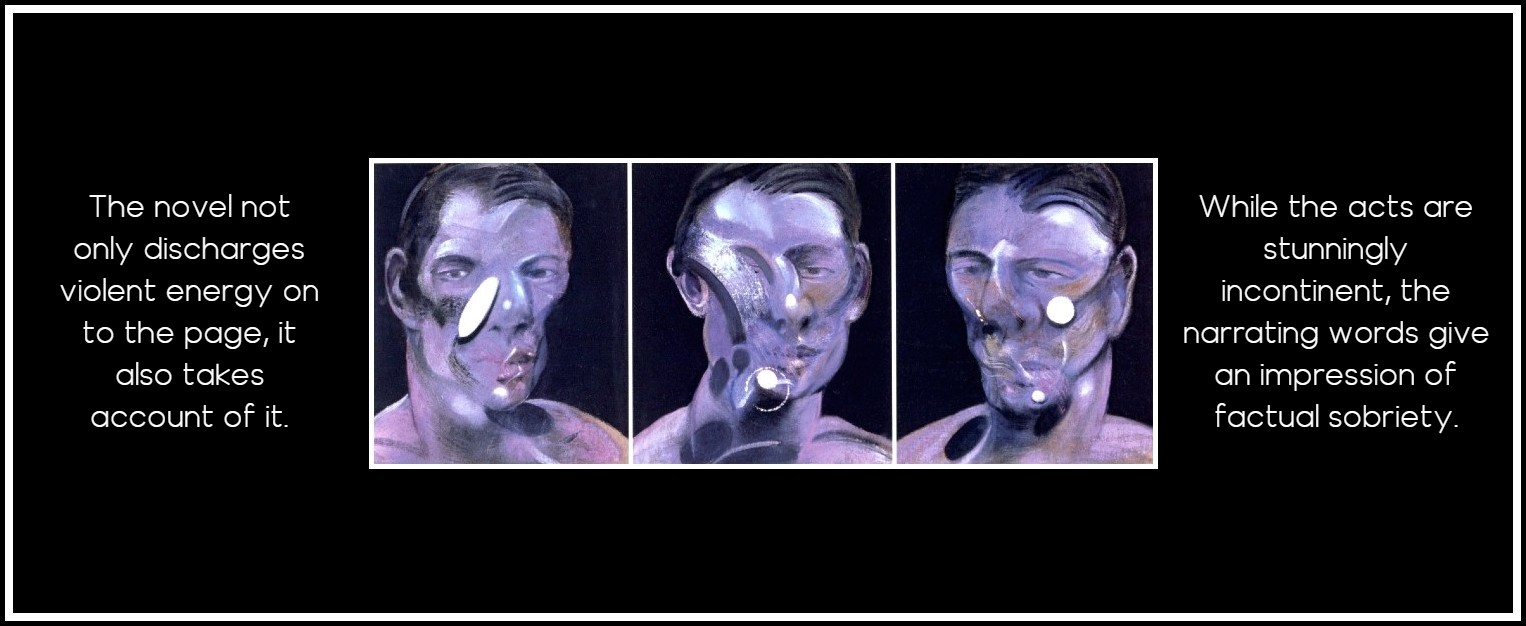
Francis Bacon, Three Studies for a Portrait of Peter Beard, 1975
‘Contradiction’ means ‘speaking against’. That is the burden of the narrator, Nelly, who speaks against the mad and bad ways of her unruly charges which climax at the centre of the book in Cathy’s delirium (Chapter XII) and Cathy’s and Heathcliff’s final meeting (Vol. II, Ch. 1). Although Nelly like Lockwood is implicated in the dreamscape of the novel through her arresting ‘vision’ of Hindley at the crossroads, she thwarts, criticizes and distinguishes herself against the visionary passion which sweeps through the novel’s centre, as a foil to Catherine’s powerful arias which cry over the gulf that separates child from adult, self from heart’s desire. ‘Ah! Nelly has, played traitor, Nelly is my hidden enemy,’ Catherine exclaims, catching her out, and at the crisis of the death-scene Nelly’s aversion is consummated in the hard-hearted thought that she’s glad Catherine’s dead rather than ‘lingering a burden and a misery-maker to all about her’. Yet Nelly is not really sure of anything. Her mind lives in constant and fluctuating dialogue with the story it must tell. Dialogue is the narrative counterpart to the ‘inevitable dualism’ of the novel’s world, its dynamic of warring contraries. The voices of the two narrators, who recurrently emerge from the narrative to discuss its implications and even the narrative method itself, exist in perpetual and irresoluble dialogue with one another as they weigh and test the meanings of events. They leave propositions forever swirling in the air: on the model of ‘people are different in the north/no, they are much the same as anywhere else’; ‘all the dead go to heaven/they do not go to heaven’.
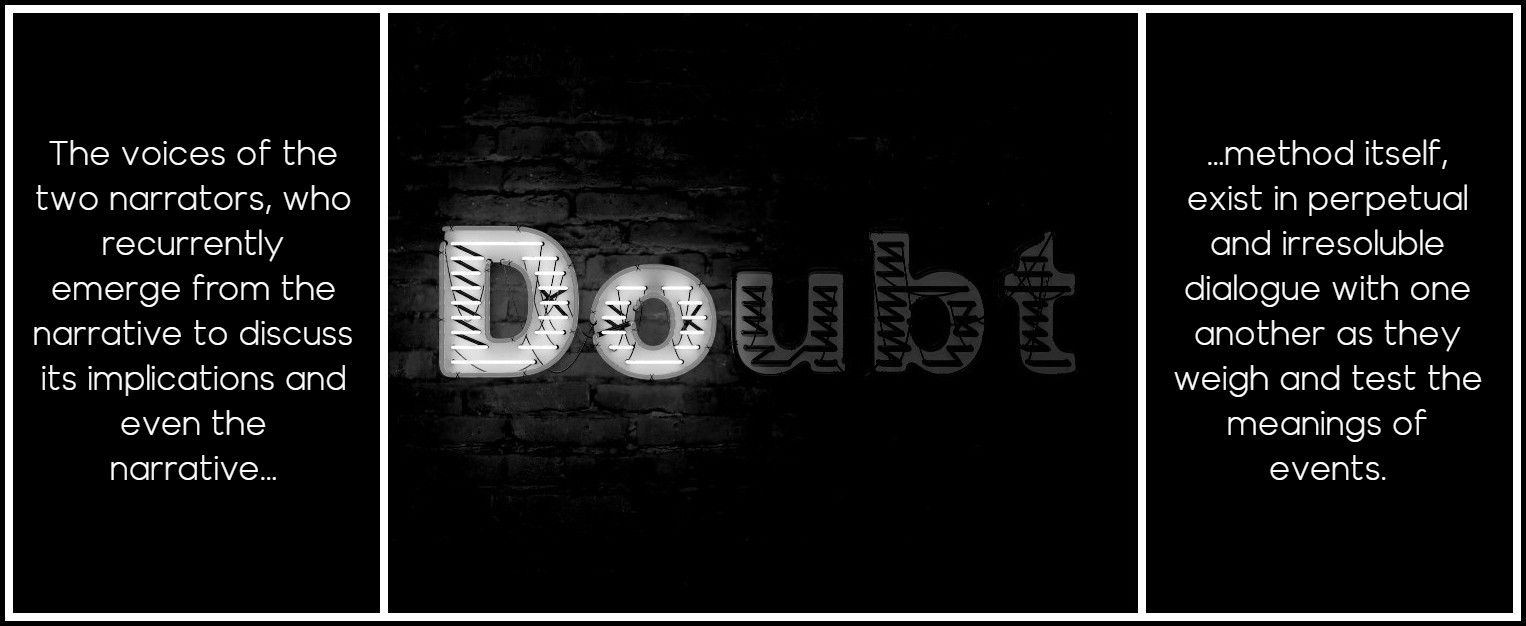
Photo: Behnam Mohsenzadeh, Unsplash
Describing the ‘perfect peace’ of Cathy’s dead face, Nelly recalls an aura of blessedness, at odds with her daredevil life. ‘Do you believe such people are happy in the other world, sir? I’d give a great deal to know,’ she interrupts herself to ask. Lockwood returns no answer to a question ‘which struck me as something heterodox’, and Nelly swiftly backtracks, fearing that the profane Catherine is probably in hell, but leaving it with her Maker to decide. But that decision contradicts the extraordinary beauty of her description of Cathy’s radiance in death and her way of passing ‘quietly as a lamb, like a child reviving’. The novel incessantly discusses with itself, disagrees with itself, converses with its own reflections, like a single mind divided upon all issues, running from thesis to antithesis and forever seeking unavailable synthesis. It is a mind luminous and aroused, with a range of manners at its disposal, dialectically interacting, so that the aggressive and affirmative style which enacts a war of words on the page is in dialogue with a language of reverie and tenderness.
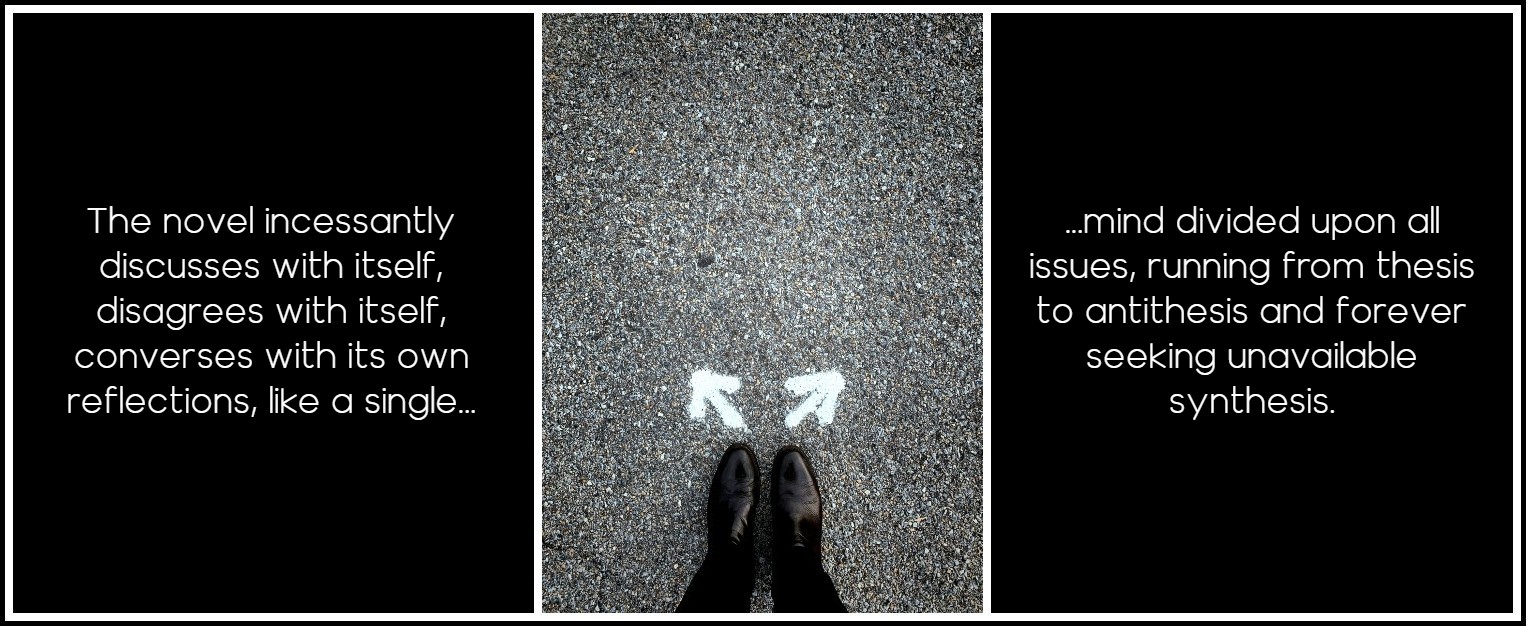
Photo: Jon Tyson, Unsplash
The novel frequently moves into the minor key, expressing the beauty of nature and natural affection in a tender, melancholy mood, with a sense of presence and harmony, the ‘soft thaw winds, and warm sunshine, and nearly melted snow’ evoked by Edgar’s gift of crocuses to Catherine; Nelly with her ‘heavy basket of apples’ in the moonlight; ‘the full, mellow flow of the beck in the valley’; the ‘golden rocks’ of Penistone. But such tender beauty itself contradicts the dissonance which is a condition of the novel: harmony is therefore in a state of quarrel. Friedrich Schlegel expressed this quality of internal dialogue in a clear and powerful form: ‘So deeply is this dualism rooted in our consciousness, that even when we are alone, or at least think ourselves so, we still think as two, and are constrained as it were to recognize our inmost profoundest being as essentially dramatic. This colloquy with self, or generally, this internal dialogue, is so perfectly the natural form of human thinking that even solitaries express themselves in a dialogue of the soul with God.’ Talking to ourselves is a norm but producing a novel capable of turning the principle of ongoing private discussion into art is extraordinary. Emily Brontë’s unique grasp of Romantic irony as a structural principle of her work—a yes implying no, a no implying yes—mediates her binary vision. As readers we seem to overhear this ‘colloquy of self’ and our reading minds move into dialogue with the debating mind of the novel.
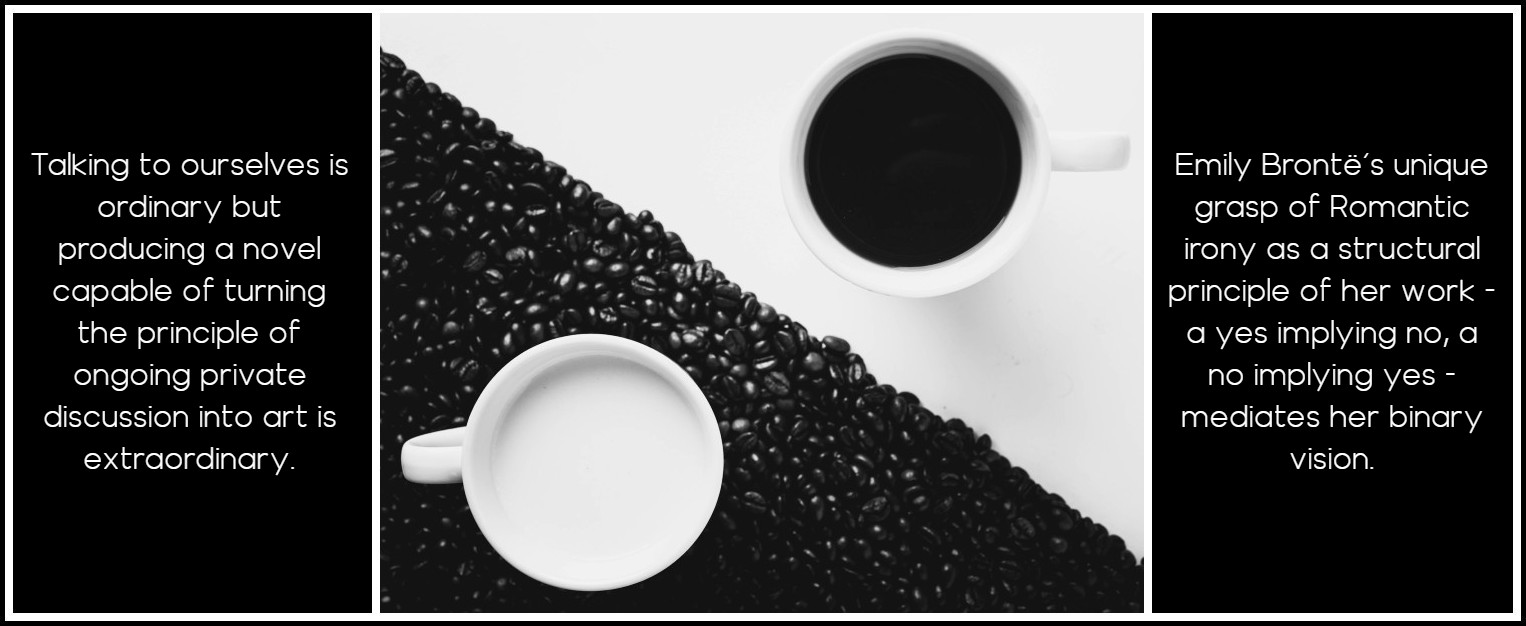
Photo: Alex Padurariu, Unsplash
In the final sentence of Volume I, Lockwood vows to resist the charms of the second Cathy, lest ‘the daughter turned out a second edition of the mother!’. Thus the bleating baa-lamb who fondly imagines mating with the daughter of a tempest ironically inaugurates a second volume in which a second generation will re-present the problems of the first and reverse their issue, through the person of a second Cathy who is not quite a ‘second edition’ but rather a revised edition of the first. Whereas the first volume, dominated by the first Cathy, moved inexorably towards tragedy and destruction, the second, involving her daughter, progresses through elimination of the hybrid Linton Heathcliff toward the establishment of the appearance of harmony and balance. However, in the cyclical world of Wuthering Heights, the ‘first edition’ is not cancelled out by the second. The first Catherine echoes, breathes, glimmers through the second half, as the spectre Heathcliff tracks; in all the places and objects with which we learned to associate her; in the echoing reminiscences of her highly-wrought spirit in the tempered but still high spirit of her daughter; even in the mirroring eyes of her nephew, Hareton. She seems not so much ‘in’ the text as ‘behind’ it; the words on the page echo but can never disclose her. Her absence signifies her, and Heathcliff’s loss exclaims against her amputation from his own person, with all the power of the newly-bereaved.
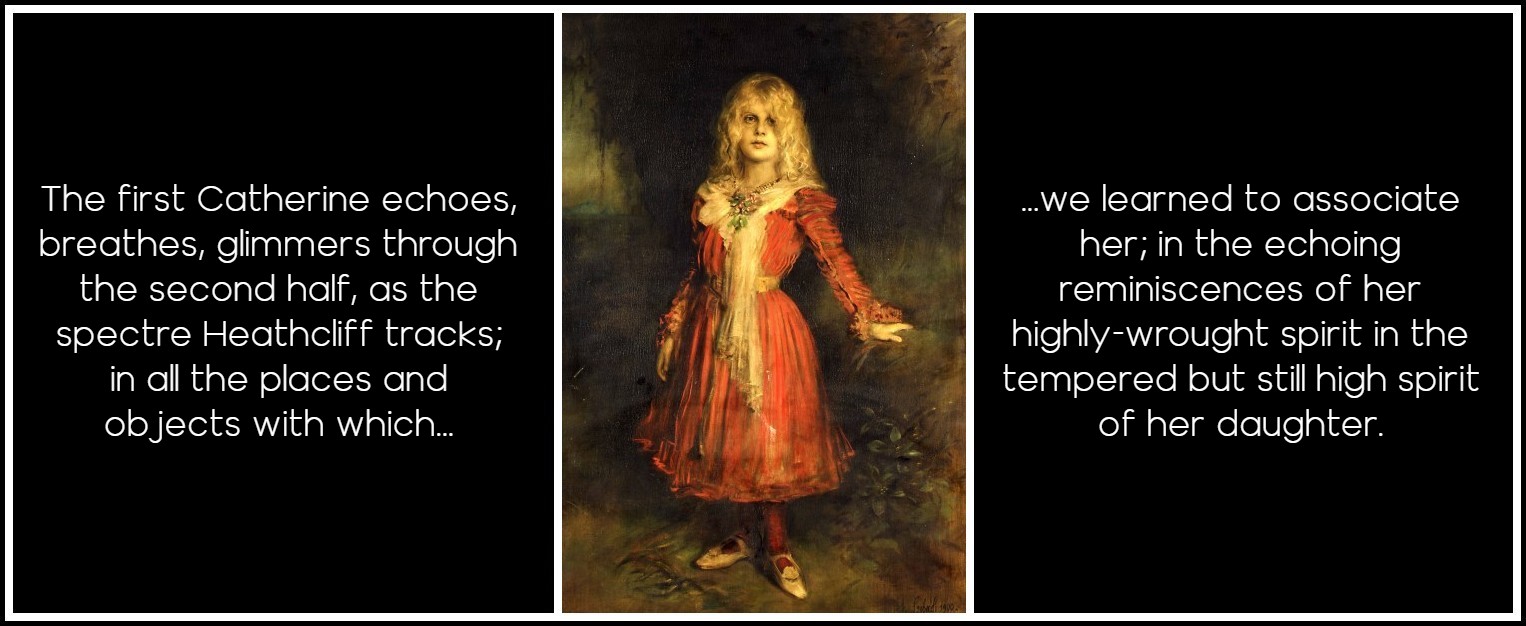
Franz von Lenbach, Marion, the Artist’s Daughter, 1900
Beginning in crescendo, the second volume dies in diminuendo. The awesome beauty and ferocity of Cathy’s and Heathcliff’s final meeting open the volume. From this clashing climax, the child is born, to find the way back home to the Earnshaw roots in a circuitous process which has something of the sense of benign destiny of Shakespeare’s tragi-comedies, especially The Winter’s Tale. The relaxation of the telling in the second part, with its discursive manner, accompanies a slackening of the dynamic tension between the tellers and the tale. Nelly’s aversion to the first Catherine gives way to scolding indulgence of the second. Lockwood, who arrived in farce, departs from the house in pique. There is more than enough of the mother in the child Catherine to make it ridiculous for the ‘outside’ narrator to think of arousing her love for his own effete person.
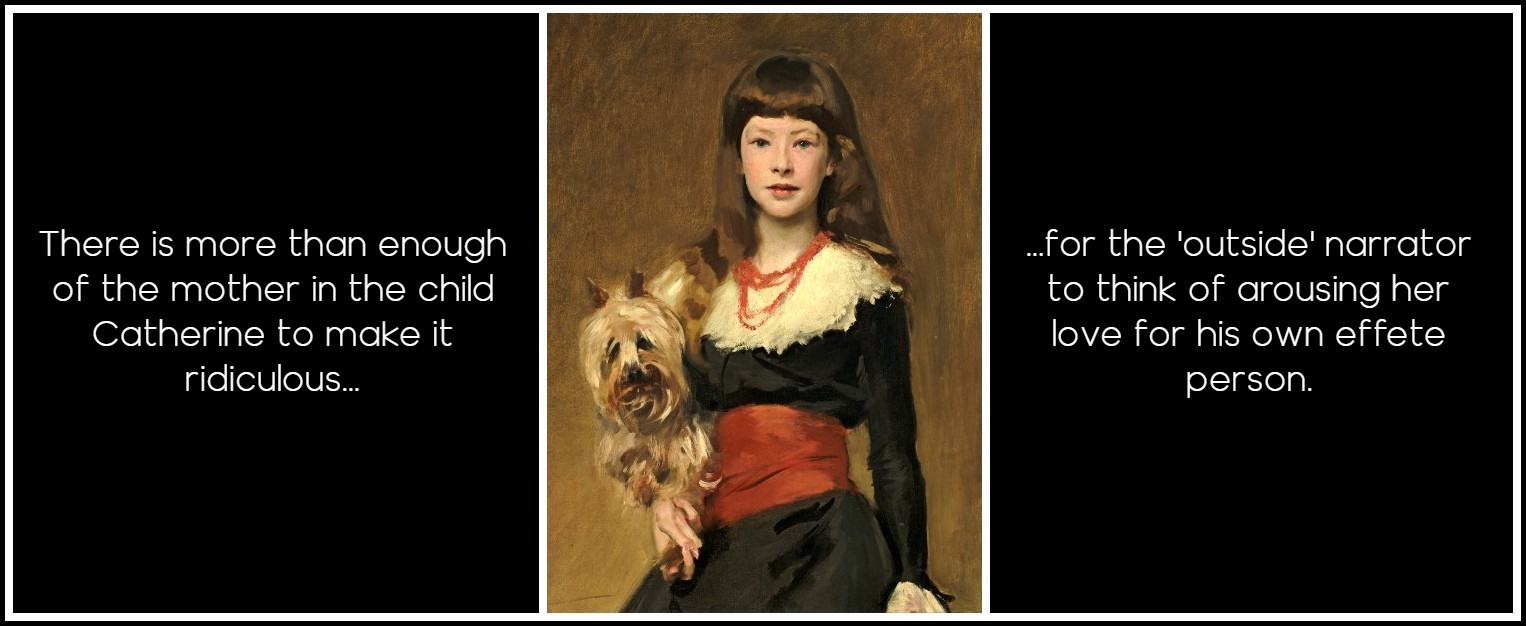
John Singer Sargent, Miss Beatrice Townsend, 1882
Nelly has noted Lockwood’s preference, which he has been intermittently confiding to readers with coyness from the earliest scenes; latterly, however, a little wisdom has dawned: ‘my home is not here. I’m of the busy world, and to its arms I must return’. We too could say that our ‘home is not here’. The ineligibility of the narrator as our representative for the ‘smiting beauty’ of the second Cathy acknowledges not simply the force of Eros and the threatening power of the ‘Earnshaw’ women, however tame, but the exclusiveness of the life of the novel, bound and sealed in to origins. Just as Lockwood’s first visit had shown us the way into the text, so his return in 1802 guides us out. Heathcliff is dead and the lovers united. There are no longer any snarling dogs to savage the intruder; on the contrary, he has been greeted in an outpost of civilization by the sweet scent of ‘stocks and wall flowers’, an open gate, windows and doors, and a girlish voice ‘sweet as a silver bell’. Lockwood approves. All is well. That is, all is quiet and normal. He is given the account of Heathcliff’s last days and the news of the wedding on New Year’s Day.
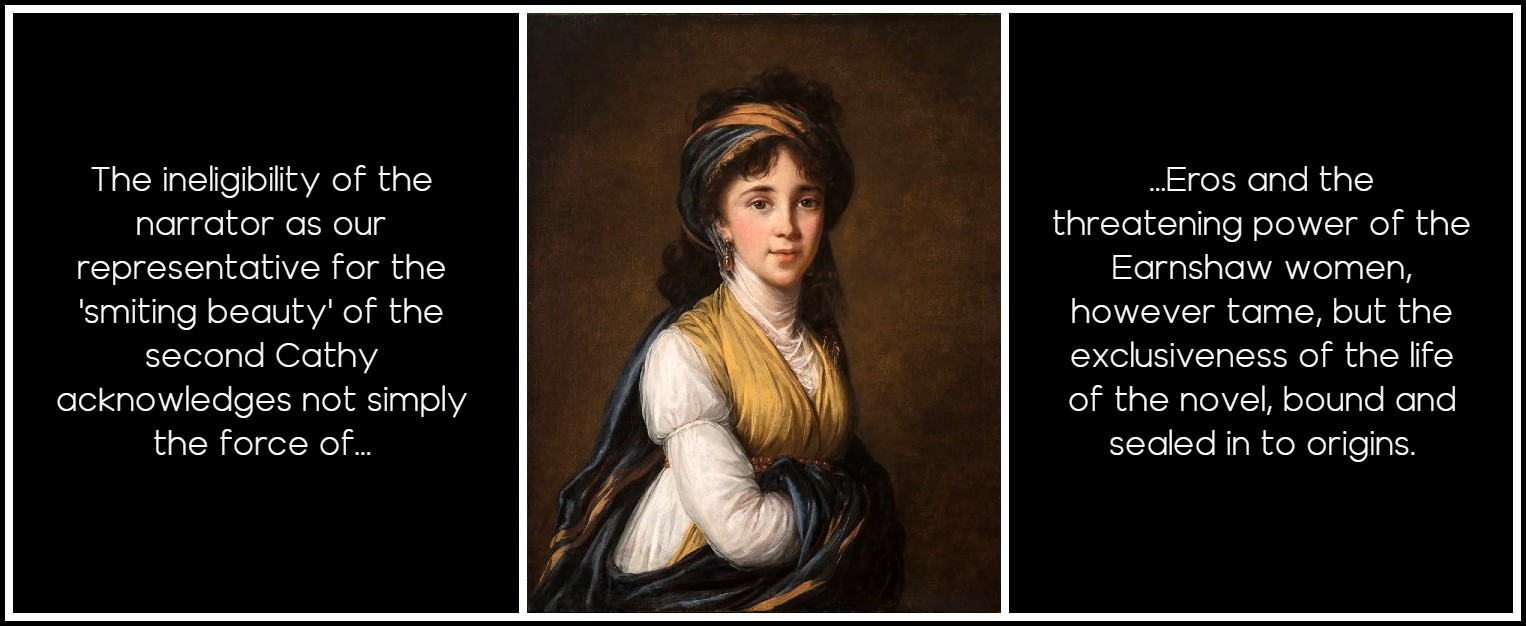
Élisabeth Louise Vigée-LeBrun, Portrait of Princess Belozersky, 1798
But that is not the end of it. We are made to feel that the story concludes (but without resolution) ‘elsewhere’. Its home too is ‘not here’. Always retrospective, half the narrative moves forward like a sleeper’s gradual ascent through the shallows of consciousness towards wakefulness; the other half travels backwards to fall away into unconsciousness. The story departs from itself as the young struggle forwards to their counterparts, and Catherine’s relicts, Linton and Heathcliff, seek for her grave and their own, their paths inexorably deathwards-tending. The novel concludes in time (the prospective marriage) and eternity (a Liebestod). But there are rival suitors in the Liebestod. Just as fanatically though not as volubly as his rival and counterpart, Heathcliff, Edgar Linton yearns toward union with Catherine in death, spending his leisure ‘lying, through the long June evenings, on the green mound of her mother’s grave’. This romantic morbidity, equating mound with marriage-bed, is a keynote of the second phase of Wuthering Heights, rivalling Novalis’ consummations at Sophie’s graveside in its excesses: ‘In the evenings I went to Sophie. I was indescribably joyful there. Flashing moments of enthusiasm—I blew the grave away in front of me like dust. Centuries were like moments. I could feel her nearness, I believed she would appear at any moment.’
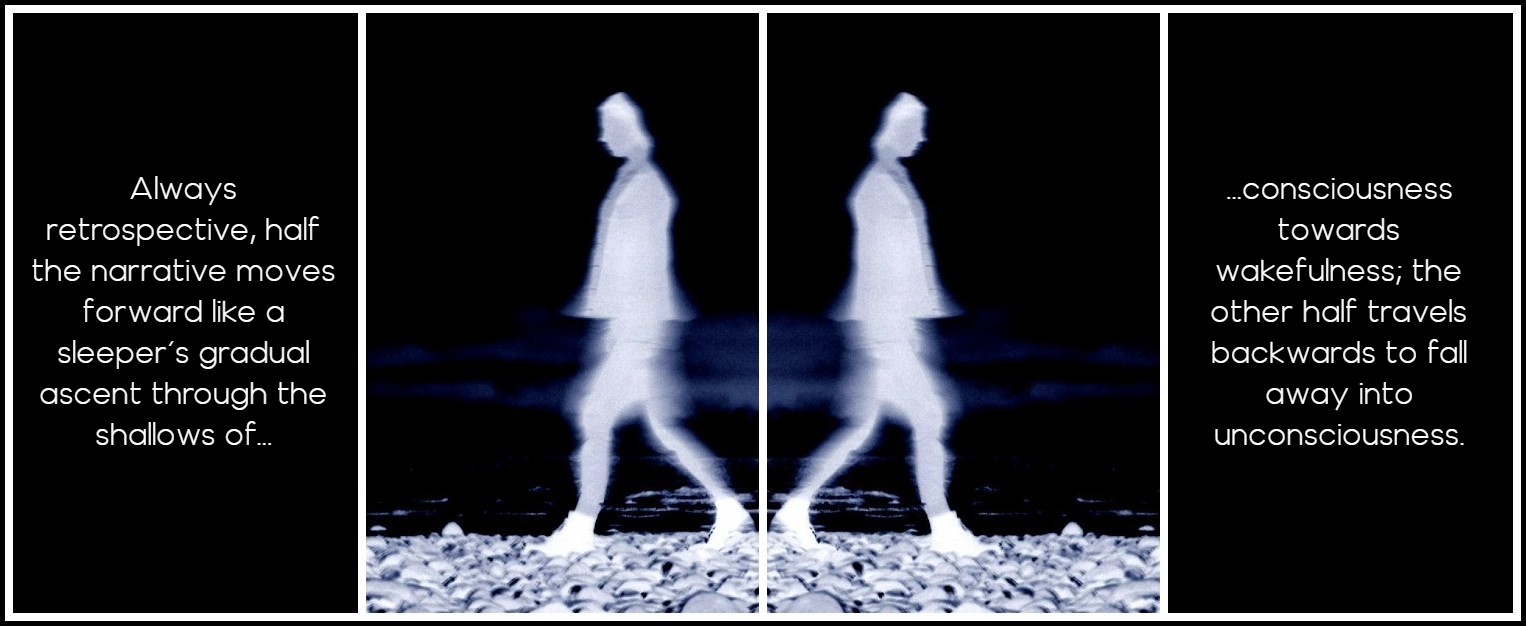
Photo: Adrian Salazar, Unsplash
Both Linton and Heathcliff are described as dying in beatitude because they are going home; going to Catherine, that is. Linton’s eyes ‘seemed dilating with ecstasy. He died blissfully, Mr Lockwood; he died so’. He and Heathcliff both will themselves into the underground bed of Catherine, with equal intensity. Edgar Linton, portrayed with sympathy and respect for his gentle and amiable characteristics (though not, perhaps, with much enthusiasm) loves without rapacity but with equal constancy. Does he find the first Catherine at the end of his vigil? Does Heathcliff, found dead with that ‘frightful, life-like gaze of exultation’ on his face, find her? With the appearance of ecstasy on the one hand and triumph on the other, the god-fearing man and the devil-daring man give tokens that they have gone to meet not their Maker, but their idol and counterpart: the same self, Catherine. The quietus of the novel, for all its serenity, is really an open question. It asserts incompatible and inconclusive resolutions with perfect sang froid while ensuring that we close the novel on the word ‘quiet earth’ with a sense of completion—an artistic effect incomparable save with Milton’s renowned ‘quiet endings’: ‘calm of mind, all passion spent’. To Lockwood’s jocularity about Wuthering Heights being evacuated ‘for the use of such ghosts as choose to inhabit it’, Nelly cuts in with a jittery ‘No, Mr Lockwood . I believe the dead are at peace, but it is not right to speak of them with levity’. For, of course, you never know. That down-to-earth axiom is the uncanny burden of the novel.
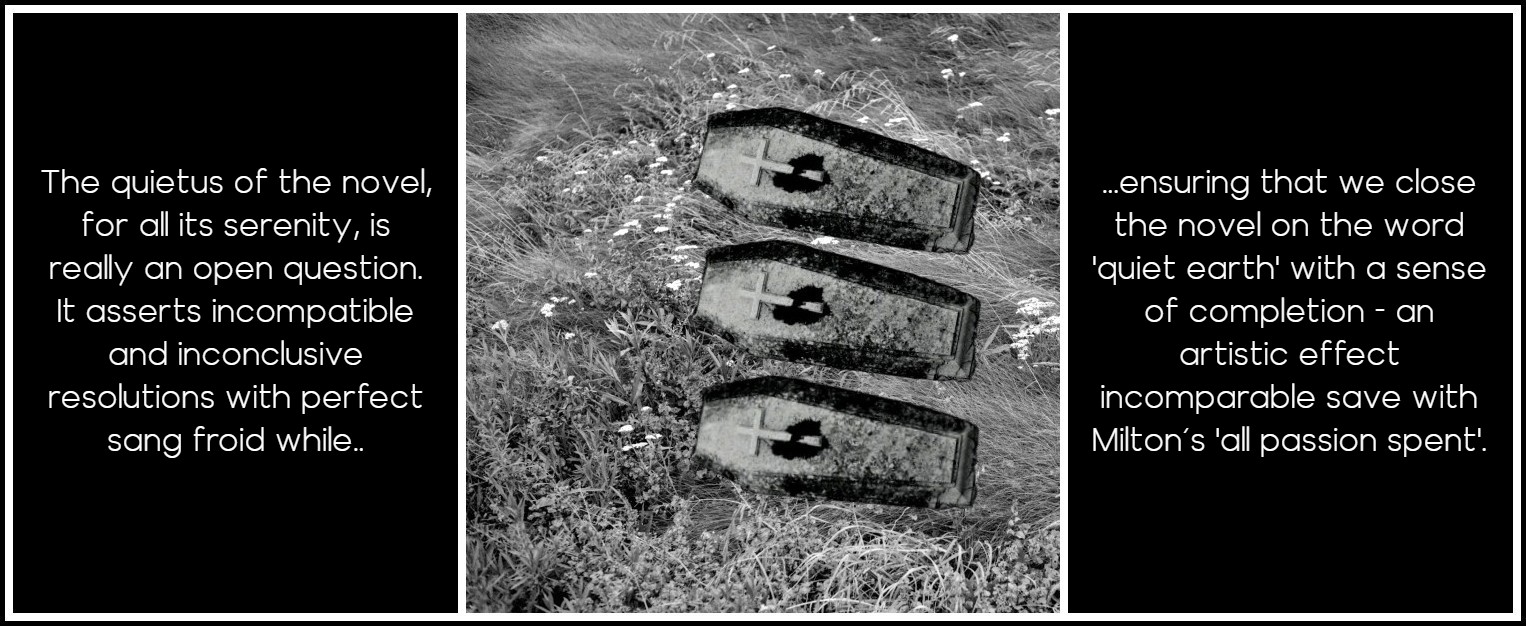
Photo: Jason Leung, Unsplash (composite: RJ)
At the end of the day, everyone needs to go home. But the location of home is the enigma upon which the mighty novel builds its equivocal, shifting structure of ‘insides’ and ‘outsides’, and ‘insides’ which are ‘outsides’; of selves which seek sanctuary, rebel against containment, multiply into doubles and shatter against the prison-bars of the rib-cage. Where did we come from and whose children are we? Am ‘I’ my home or are ‘you’? How can I get out of myself and into you when I am beside myself, out of my mind, trying to do so? Is this house or that my home, or is nature? Is heaven my home, or hell? Can I feel at home with my name and, if names change, must I or can I? When was I most at home with myself – if in childhood, how can I get back to who I really was before I became this adult stranger? How come my gender betrays and belies me, halving my wholeness and stranding me on one side of an unclimbable wall of which I was once unconscious? How can consciousness be reconciled with the unconscious, culture with nature, bond with free? These deep and searching questions preoccupy Wuthering Heights as, in less articulate and intellectually controlled form, they, preoccupy its readers all their lives.
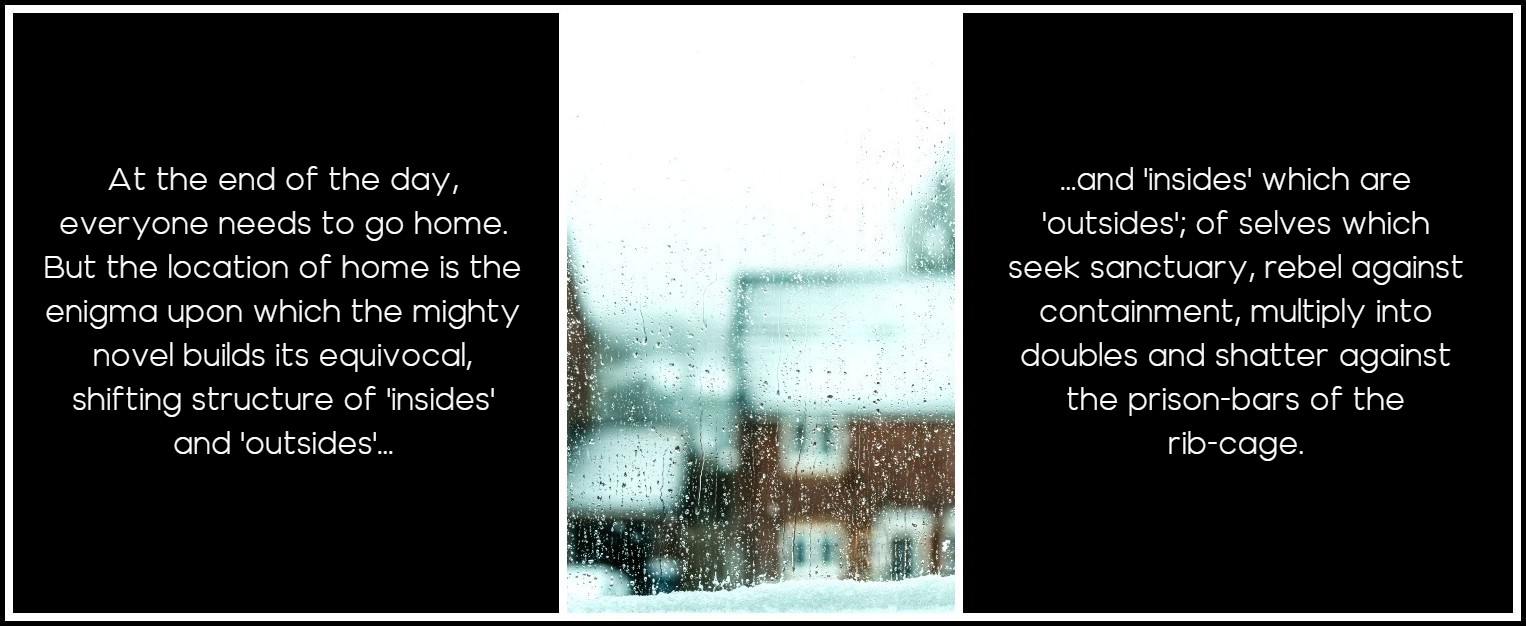
Photo: Toa Heftiba, Unsplash
Despite the urgency of such questions, of permanent and paramount importance, most of us cannot answer them save with lazy and temporary solutions and find difficulty in stating them adequately. With concise and severely formalist constraint, Wuthering Heights’ double-talk succeeds in stating the questions. It presents, through its intricate arrangement of narrative boxes, intimations of transcendence framed by the skepticism of the rationalist. It asserts nothing. It asks everything. Its reply to our interrogations is always a kind of rebounding of those questions against themselves; an echo which affirms only that the desired person is not here, the time not now, the need not answered. But the ‘Gothic’ aura of the uncanny which pervades the work implies that though we live in loss, and at a loss, the thing, person or place lost may be ‘elsewhere’—adjacent, proximate, but not (yet) accessible. Wit builds the walls of the novel of some perverse material capable of turning outside-in and inside-out with dexterity. Silent and self-effacing word-play, innuendo and puns form a staple of this two-faced building material: ‘My home,’ said Lockwood to Nelly, ‘is not here’. In the end that is true of most persons in the novel and perhaps those reading the novel. Our home is ‘not here’. That is all that can be said with certainty about our situation.
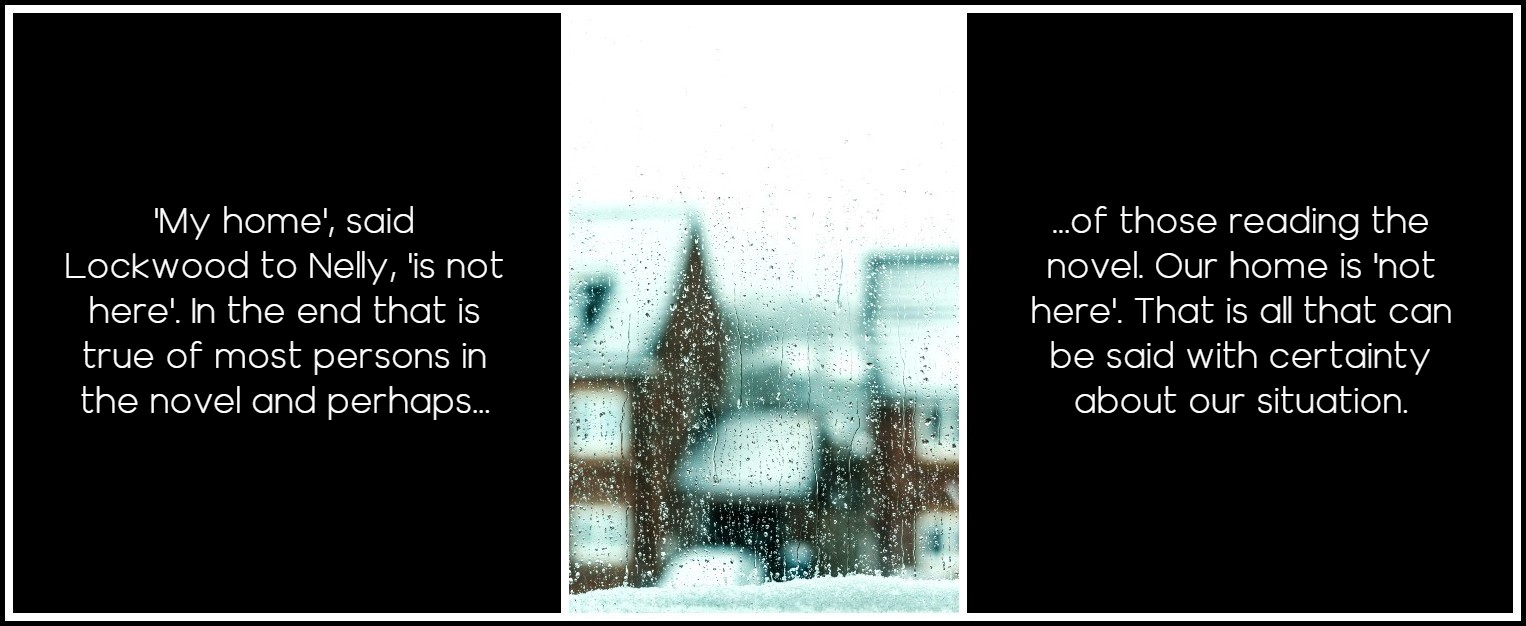
Photo: Toa Heftiba, Unsplash
Yet at the end of the novel there is a profound sense of homecoming. Along with Lockwood, we reach a resting-place that is not simply the terminus of the narrative. Catherine and Hareton will vanish, going down to the Linton valley; the Heights, vacated of all but Joseph, is destined perhaps to decay, like the church, into the original rocks beneath from which it was raised. Nature takes back these transient human fabrications; no regret attends such assimilation. Neither is there a feeling at the close that there is any harm in being dead. For one is still, even while dead, being; but differently. Being still is still being. Emily Brontë’s life’s work brings consciously into question the issue of whether life is, in the event, worth living. Might it have been better never to have been born in the first place? An insomniac’s strain and exhaustion make the thought of eternal sleep a balm: O for the time when I shall sleep / Without identity, / And never care how rain may steep / Or snow may cover me!.1 But this attitude, the toll of sensitive wakefulness in a world of suffering, though final in narrative time in Wuthering Heights, is not definitive. The novel expresses in its very rhythms and line-by-line play of creativity, the dialectically opposed attitude, corresponding with the second Cathy’s idea of heaven’s happiness: …with a west wind blowing, and bright, white clouds flitting rapidly above and the moors seen at a distance, broken into cool dusky dells; but close by, great swells of long grass undulating in waves to the breeze; and woods and sounding water, and the whole world awake and wild with joy. He wanted all to lie in an ecstasy of peace; I wanted all to sparkle, and dance in a glorious jubilee.
1 – ‘The Philosopher’ A27
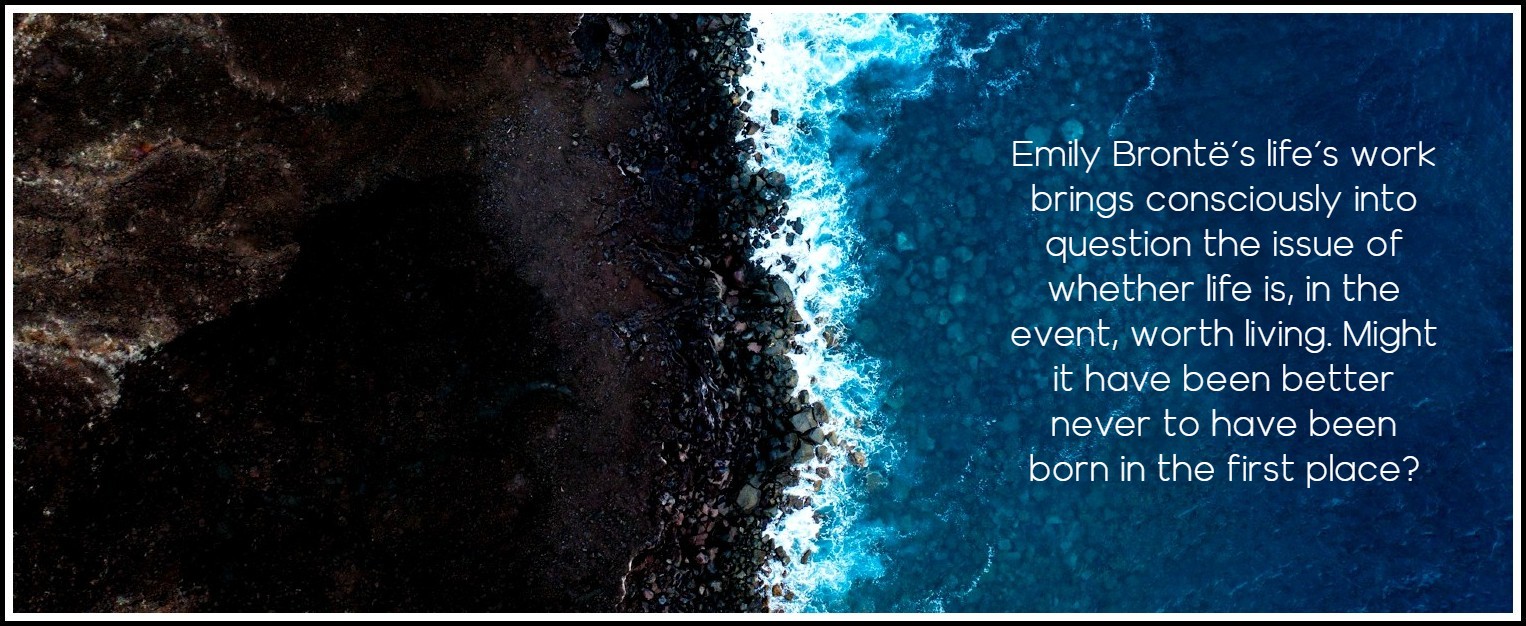
Photo: Alexis Antoine, Unsplash
Internal rhyme (‘bright, white; dells, swells’) and a spree of alliteration (‘west wind; white, swells; waves, woods; water, world; awake, wild; wanted, wanted’) mediate an exultation in being alive and awake that one would not voluntarily forfeit. Cathy’s espousal of motion quarrels with her cousin’s affinity with stasis and peace; a dispute which is voiced in the comic key forthwith: ‘I said his heaven would be only half alive, and he said mine would be drunk; I said I should fall asleep in his, and he said he could not breathe in mine, and began to grow very snappish’. On the binary ‘I said/he said’ principle parodied here, Wuthering Heights makes a tremendous case for life on earth, awake and conscious, while it also denies the value of life in this mighty stranger, the universe.
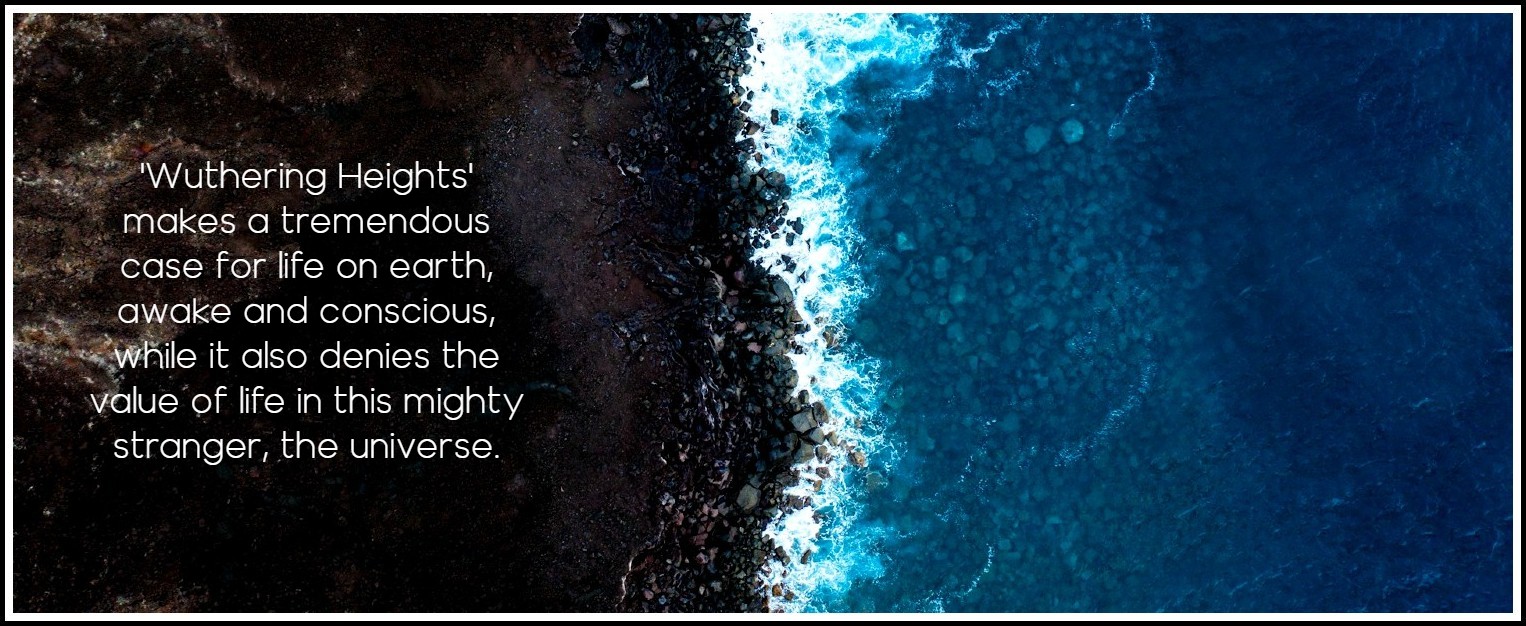
Photo: Alexis Antoine, Unsplash
The last sleep accomplishes the return journey to the first sleep; and though the leave-taking is hard and full of turmoil, and the bereaved are struck doubly homeless in the ‘empty world’, the ‘dark world’, those who have left are well out of it. ‘Who’s given us the slip now, do you think?’ asks a minor narrator, Dr Kenneth, of Nelly, preparatory to imparting news of the death of Hindley. His brash colloquialism says it all: the dead are runaways from the story, breaking out of the prison of mortality (and hence from narrative itself, which is constrained to time) by the only trustworthy route. Kenneth’s job as a physician is a form of police-work, the profession dedicated to keeping unwilling inmates inside bounds. And he speaks like a warder too: ‘He’s been too wild for me this long while’. The dying abscond, scot-free. It is from this perspective that we can see that the exquisite nocturnal of the concluding paragraphs of Wuthering Heights does not constitute precisely an elegy:
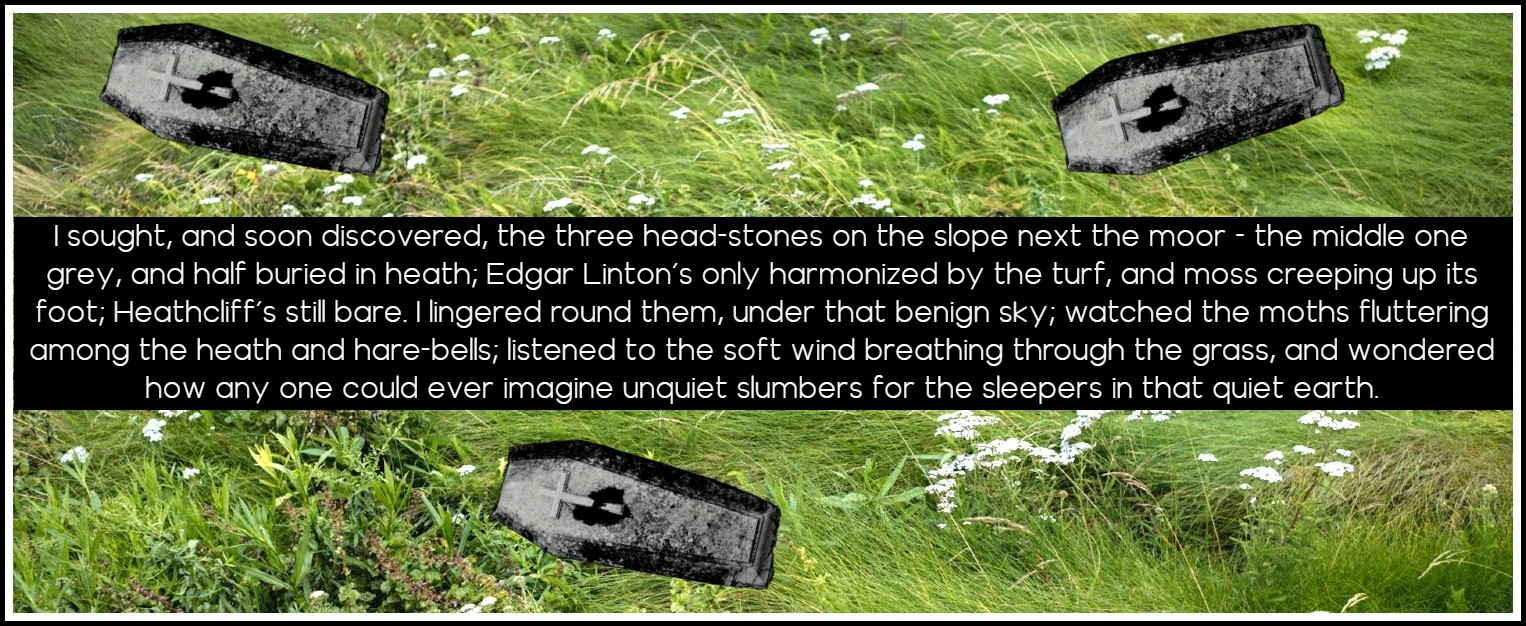
Photo: Jason Leung, Unsplash (composite: RJ)
An echo of ‘Heathcliff’ breathes in ‘heath’, of ‘Hareton’, ‘Isabella’ and ‘Ellen’ in ‘hare-bells’. The poetry of the final sentence communicates the balance of a kind of prose quatrain, founded on alternating alliterations in the verbs which recall the composure of Lockwood’s physical and mental activities at this site of beauty and stillness: ‘I lingered, watched, listened, wondered’. To ‘linger’ is to delay the speedy exit he had proposed; to ‘watch’ and ‘listen’ are to be open to sights and sounds in a receptiveness which culminates not in a decision or conclusion but in ‘wonder[ing]’. There is no finality, only the suspense of meditation, itself dualistic for, while the thinker conceives only of a conclusive quietude, he must take account of the opposite theory, held by others, ‘any one’. What Lockwood can conceive has never been the measure of the novel’s truth. And so the quietus sways upon twin oppositions chiastically balanced: unquiet: slumbers – sleepers: quiet.
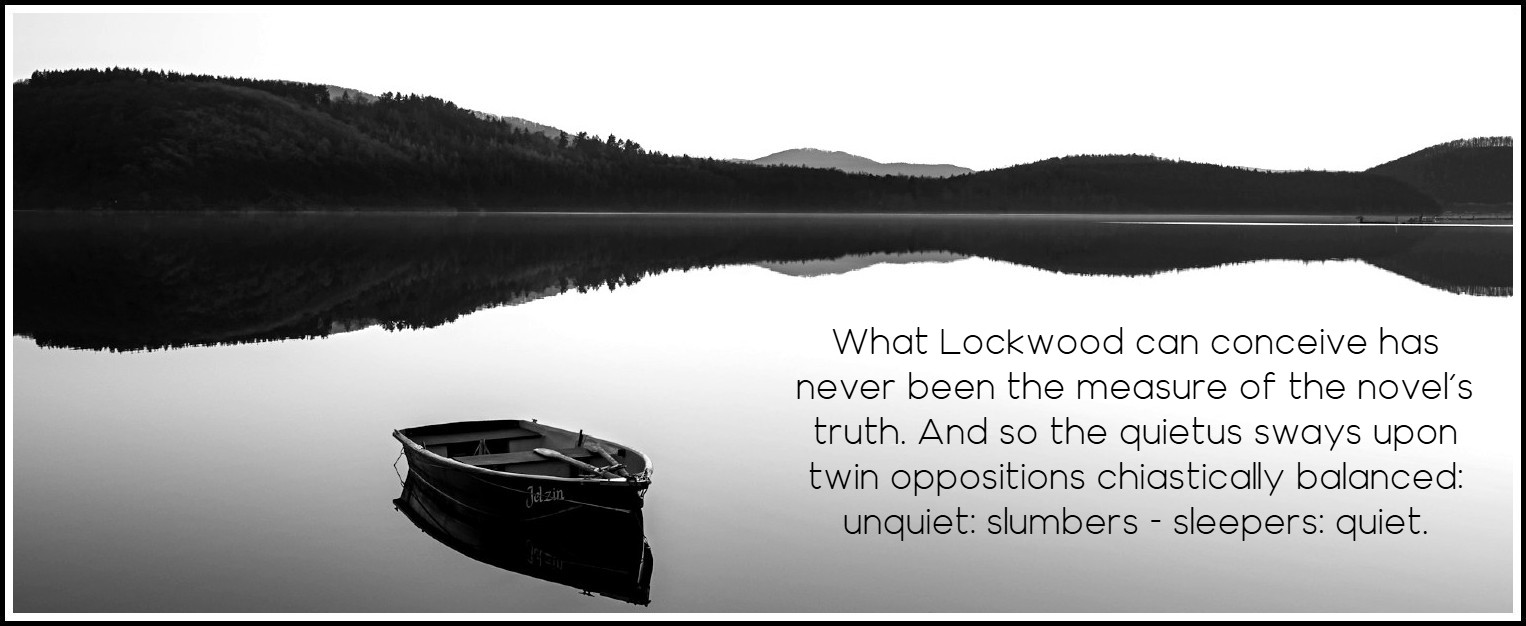
Photo: Evgeni Tcherkasski, Unsplash
However, the music of these repeated words itself is quietening. There is a sense of blessedness in the words; an absence of ruth. The terrible question, Where are you? is no longer pressing, not because it can be answered with any precision but because individual identity is no longer of any moment. As in Scott’s beautiful graveyard scene in Old Mortality which presents the dead as ‘identified with their mother earth’, the three friends and enemies of Wuthering Heights are ‘identified’ elsewhere, whether within the ‘quiet earth’ or in some resurrected form signalled by the ‘moths fluttering among the heath and hare-bells’ (emblems, like the butterfly, of rebirth) or in the form of intermingled spirit, their communion overheard in ‘the soft wind breathing through the grass’, at liberty. The persons, wherever they may be, are beyond us, elsewhere. They may be in both worlds simultaneously, ‘The dungeon mingled with the mould / The captive with the skies’;1 or not. It does not matter; makes no difference. For difference is cancelled in this final transformation of persons out of our ken, as the novel turns away from its reader, into silence. In choosing as its final word ‘earth’, it gestures to the source of all being and the erasure of all distinctions, including that which represents identity and its loss: writing. Their names will be erased as heath and moss absorb the inscriptions into profound unconsciousness.
1 – ‘Aye, there it is’, A9
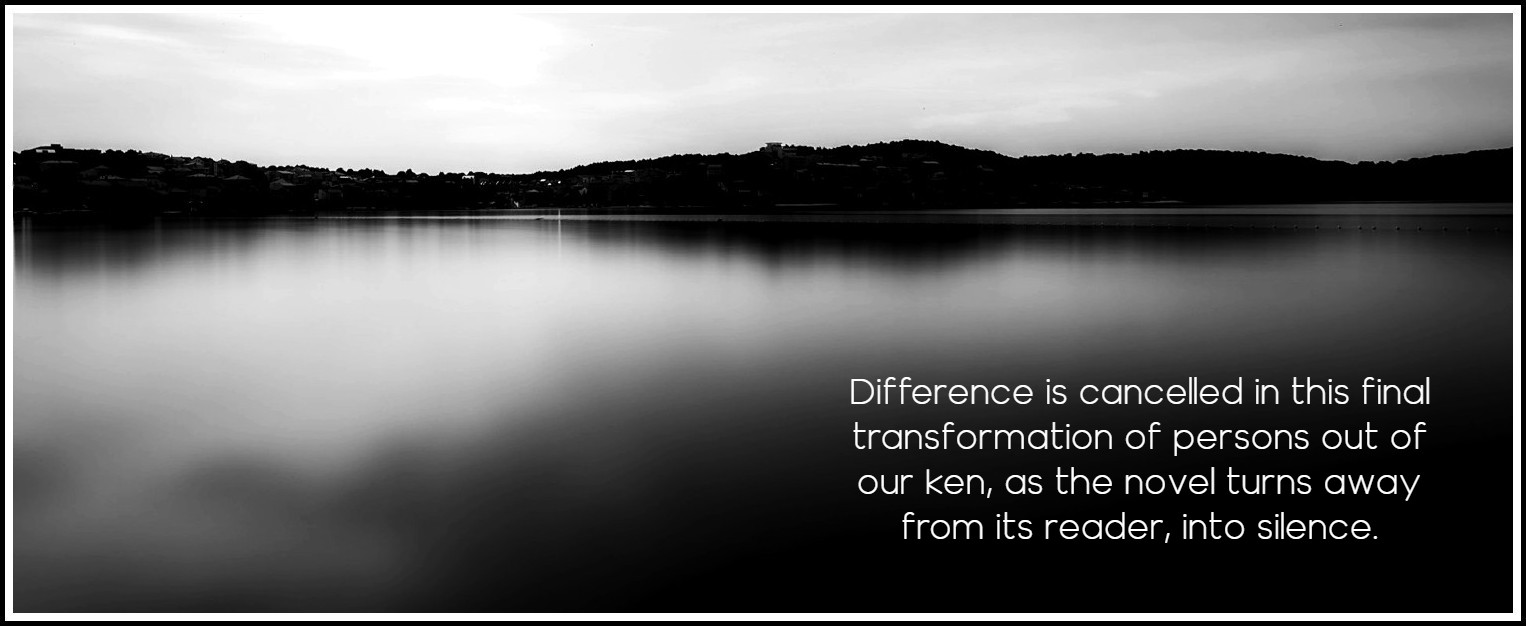
Photo: Noel O’Shaughnessy, Unsplash
STEVIE DAVIES – THREE NOVELS
CLICK ON THE IMAGE TO GO TO A DESCRIPTION OF THE BOOK
MARA, MARIETTA: A LOVE STORY IN 77 BEDROOMS – READ THE FIRST CHAPTER
A literary novel by Richard Jonathan
RICHARD JONATHAN, ‘MARA, MARIETTA: A LOVE STORY IN 77 BEDROOMS’ — READ THE FIRST CHAPTER
AMAZON & APPLE BOOKS
RICHARD JONATHAN, ‘MARA, MARIETTA: A LOVE STORY IN 77 BEDROOMS’ | AMAZON PAPERBACK OR KINDLE
RICHARD JONATHAN, ‘MARA, MARIETTA: A LOVE STORY IN 77 BEDROOMS’ | APPLE iBOOK
MARA, MARIETTA: A LOVE STORY IN 77 BEDROOMS
A literary novel by Richard Jonathan
RELATED POSTS IN THE MARA MARIETTA CULTURE BLOG
CLICK ON THE IMAGE TO GO TO THE POST
By Richard Jonathan | © Mara Marietta Culture Blog, 2025 | All rights reserved
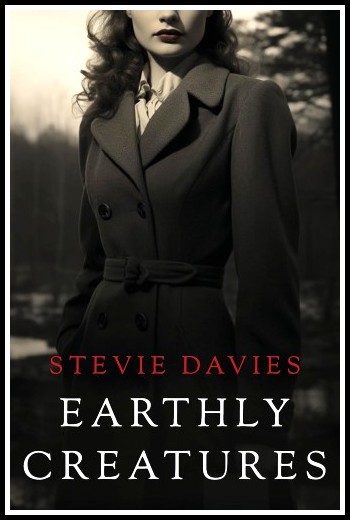
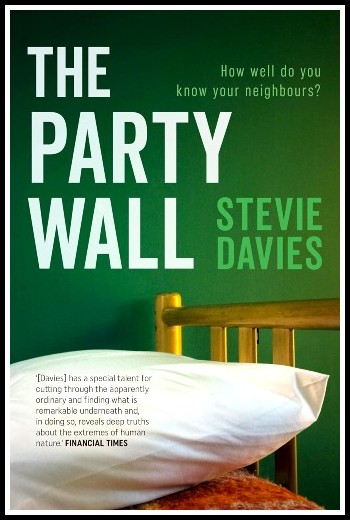
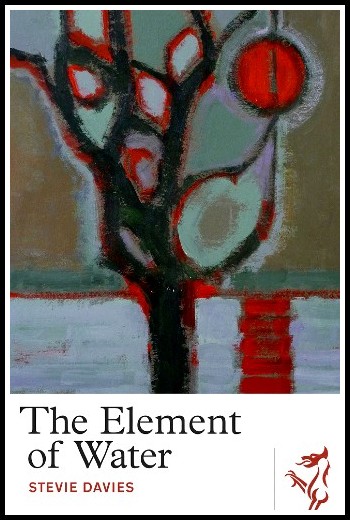
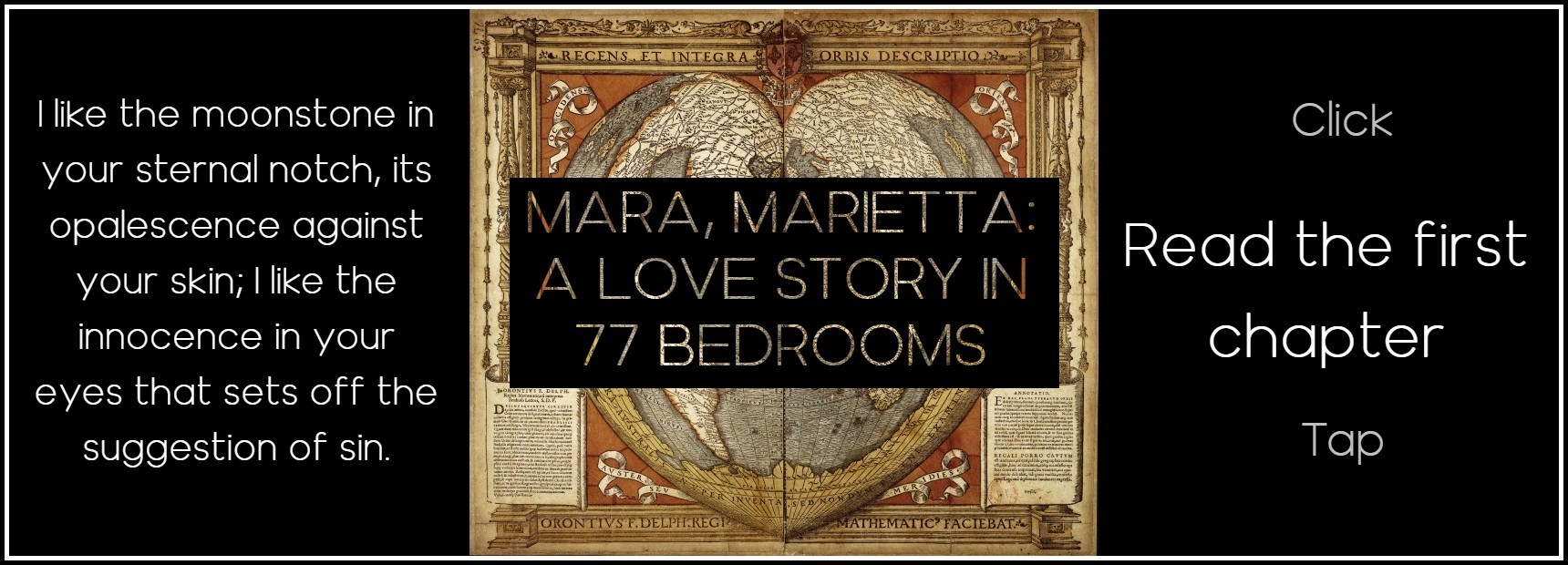



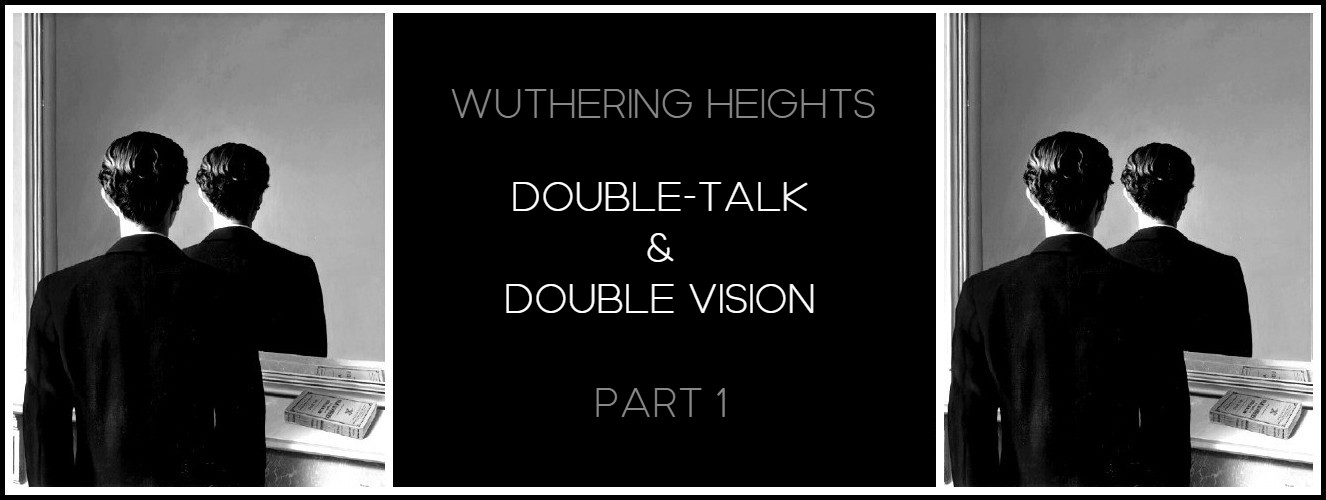

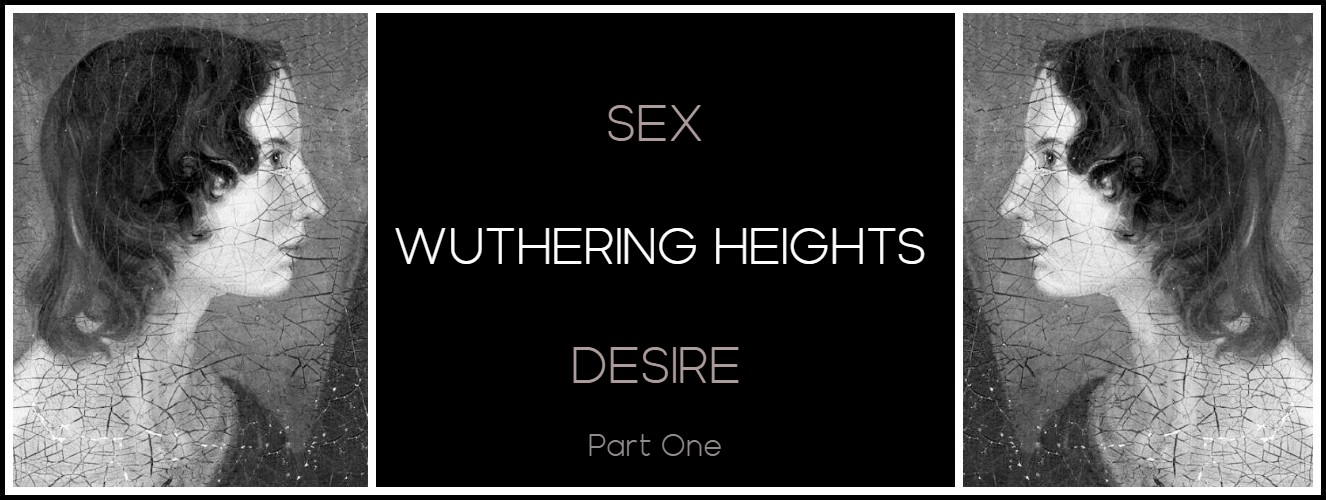
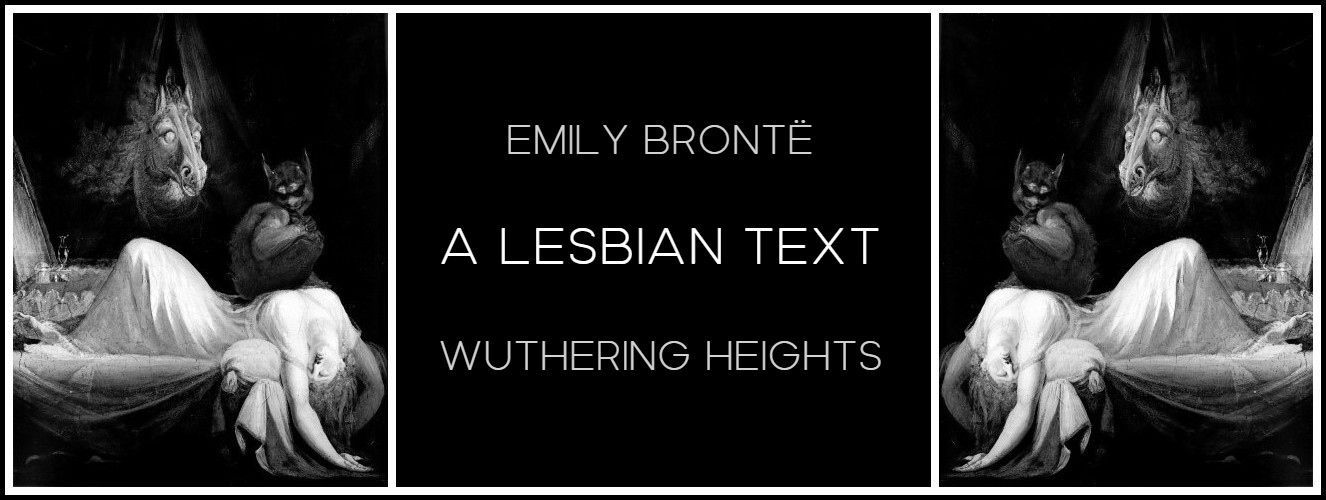
Comments